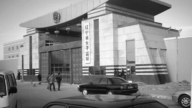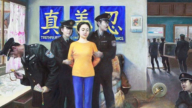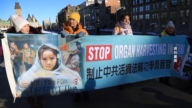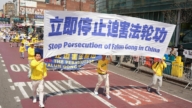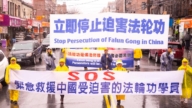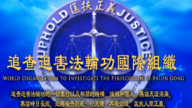【新唐人2013年11月02日讯】北京天安门汽车爆炸事件发生后,中共当局立即对事发现场进行了严密封锁,甚至扣押了多名在场的外媒记者,之后又发出禁令,严控传媒及网路消息。中共对于这类突发事件所采取的一贯处理手段,与12年前,同样发生在天安门前的一起自焚案截然不同。12年前中共在自焚事件发生之后迅速报导,并且播放了现场拍摄完整的录像,长时间对民众宣传。
震惊中南海的北京天安门汽车爆炸案发生后,引发了全球媒体的关注,但中共当局不但立即出动大量军警封锁了现场,中南海附近的主干道也拉起了警戒线﹔地铁、公交车不得在天安门站停靠。
当天有6名香港记者在事发现场采访被扣留15分钟,并与公安激烈争辩。《法新社》两名记者也被拘留,记者所拍摄的影像被强迫删除。
另一方面,中共国务院网路信息办公室向各大网站发出报导禁令,使得大陆网站和微博几乎看不到爆炸案的相关消息和评论。
中共当局对爆炸事件的严密封锁,使人们联想到12年前同样发生在天安门广场的自焚事件。
“追查迫害法轮功国际组织”负责人汪志远:“这一次在天安门发生的车辆碰撞事件,和2001年1月23日发生的所谓天安门自焚事件,中共的报导和处理方式显然是不一样的,这一次事件发生以后是全面的封锁消息,而那一次,中共是在事件发生之后迅速报导,而且播放了现场的录像,并且还有特写镜头。在以后的很长一段时间内,在全世界范围内大肆的宣扬。”
显然,中共处理当年所谓“法轮功自焚事件”的手法,完全不符合中共当局处理突发事件的一贯态度。这一点,从近年来不断发生访民在天安门前自焚的事件也可以得到证实。
据中国《权利运动》组织报导,2010年中共十七届五中全会第一天,天津回族访民张培馨驾驶私家车与丈夫一起在天安门前,用汽油将车点燃自焚,大火虽被扑灭,但夫妻二人生死不明,现场照片在网上遭到删除,媒体不见任何报导。
《维权网》也曾报导,河南省洛阳访民杨华北和李红军,2010年3月29号在天安门自焚,杨华北送往积水潭医院抢救,生命垂危,消息立刻被封锁。还有,江苏邵云黎、河南王群凤在天安门前用汽油准备自焚,被天安门分局抓走后下落不明。
另据不完全统计,近年来发生在天安门的自焚事件不下几十起,却没有一起在大陆媒体公开报导,而自焚者无论当场死亡或者重伤,几乎全部失踪,与外界失去联系,相关消息也遭到当局全面封锁。
为何中共对待所谓的“法轮功自焚案”,却一反常态的大肆宣扬呢?
汪志远:“一个是中共在无效的进行了一年多的迫害法轮功之后,仍然无法煽动起全国民众对法轮功的仇恨和对迫害的认同。第二方面,中共对法轮功学员持续不断的到天安门广场请愿、拉横幅这些行为,感到沮丧和愤怒,也想清场。第三,中共也迫切需要借助名义,缓解国际社会的抗议和批评。”
美国《时代杂志》报导说,在“自焚”事件发生前,中国大陆民众认为法轮功不构成威胁,政府的镇压行动与事实不符;但在“自焚”事件经党媒大肆宣传后,民众态度产生了明显影响。
“追查迫害法轮功国际组织”指出,经过多方调查,有大量证据可以证明所谓的“天安门自焚事件”是中共当局为了构陷抹黑法轮功,而精心策划制造的“世纪伪案”,其中包括所谓“自焚者”的语音分析、中共《央视》录制的“自焚”录像分析、抢救“自焚者”的积水潭医院医生的证词等。
采访编辑/张天宇 后制/黎安安
China Censors Tiananmen Car Incident: Promotes False Self-Immolation
Following the Tiananmen car crash incident,
the scene was immediately blocked.
Several foreign journalists were
temporarily detained at the site.
Media coverage was strictly controlled,
and all related news was censored.
When this is compared with the alleged self-immolation
incident that took place in Tiananmen Square 12 years
ago, the regime dealt with them in very different ways.
12 years ago, the media quickly reported on the incident.
Footage of the alleged self-immolation was
broadcast throughout China over a long period of time.
The recent Tiananmen incident shocked Zhongnanhai
high-level officials, and aroused global media interest.
Many police were dispatched to the site, and
main roads near Zhongnanhai were blocked.
Subway trains and buses weren’t
allowed to stop in Tiananmen station.
On that day, six Hong Kong journalists were detained
for 15 minutes while they reported the news at the site.
The six reporters argued with police.
Two AFP journalists were arrested, and video and
photos were forcibly deleted from their cameras.
In addition, the State Council Information Office
issued ban orders to the major websites.
Thus the related news was hardly
seen on the internet and Weibo.
The strict censorship makes people recall the self-immolation
incident that took place in Tiananmen Square 12 years ago.
Wang Zhiyuan, director of the World Organization
to Investigate Persecution (WOIPFG) of Falun Gong:
“The CCP handled the Tiananmen incident is
different in a different way from the self-immolation.
This happened on January 23, 2001.
News about the Tiananmen crash is totally censored,
but, the “self-immolation” incident was quickly reported.
In addition, there was live video recording
being broadcast, even using close-up footage.
It has been broadcast and promoted
for a long time throughout the country.”
In order to defame Falun Gong, the means
in which the CCP handled the “self-immolation”
incident doesn’t reflect its common practices.
In recent years, many incidents of petitioners self
immolating in Tiananmen Square has proved this point.
Human Rights Campaign in China reported that on the
first day of Fifth Plenary Session of 17th CCP Central
Commission in 2010, Zhang Peixin, a Muslim petitioner
from Tianjin, drove a private car with her husband.
They ignited petrol, set fire to the car
and self immolated in front of Tiananmen.
The fire was controlled, but the
couple’s survival was unconfirmed.
The photos of the scene were deleted,
with no media coverage on the incident.
Weiquanwang.org reported in the past that petitioners
Yang Huabei and Li Hongjun from Luoyang City, Henan,
self-immolated in Tiananmen Square on March 29, 2010.
Yang was sent to Jishuitan Hospital for emergency treatment.
Yang was in a critical condition, but the news was censored.
Petitioner Shao Yunli from Jiangsu and Wang Qunfeng
from Henan are set fire to themselves.
They were arrested by police, but no
one knows their current whereabouts.
According to incomplete statistics, there have
been tens of self-immolation incidents that have
taken place in Tiananmen Square in recent years.
None of the media reported on the incidents, and all
the victims who died or were badly injured at the sites
are missing, or have lost contact with the outside world.
All related news was censored.
Why did the regime widely broadcast the
false “Falun Gong self-immolation”?
Wang Zhiyuan: “After a year of failed persecution
of Falun Gong, the CCP struggled to incite
the nation’s hatred against Falun Gong.
The Chinese people also did not its persecution.
The CCP felt dismayed and furious towards Falun Gong
practitioners’ repeatedly protesting in Tiananmen Square.
The CCP wished to change perceptions, and urgently
needed an excuse to ease international criticism.”
Times Magazine reported that before the alleged
self-immolation incident happening, Chinese
people believed Falun Gong didn’t pose a threat.
The authorities’ suppression wasn’t supported.
However, state-owned media widely reporting propaganda
obviously changed Chinese people’s subsequently.
WOIPFG indicates that the 2001 incident
was investigated by several channels.
A large body of evidence shows that this
“self-immolation” in Tiananmen Square was
CCP propaganda, to help defame Falun Gong.
Evidence includes voice analysis of the self-immolator’s,
and video analysis of China’s Central Television footage.
It also included doctors’ testimonies from Jishui
Hospital, where the self-immolators were sent.


